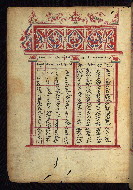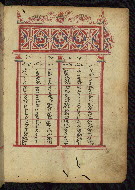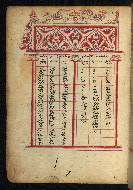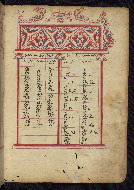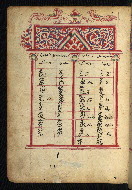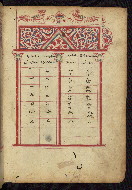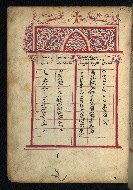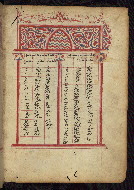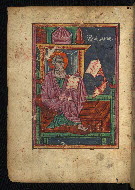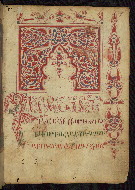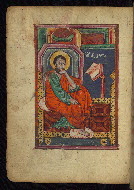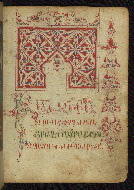Home > Digitized Walters Manuscripts
This document is a tranformation of a TEI P5 XML manuscript description incorporating images. If you have trouble reading special or non-Latin characters on this page, please make sure you have appropriate Unicode fonts installed and an up-to-date web browser.
Walters Ms. W.542, Silver Gospels
Browse images (Browse images in a new window) | TEI in XML format
W.542
Silver Gospels
Vernacular: Աւետարան
This Gospels manuscript was written in 937 of the Armenian era [1488 CE] in the province of Ekełeac' by the priest Łazar at the monastery of Surb Awgsend (St. Auxentius). Though the fifteenth-century manuscript was not a terribly costly production, it later came to be housed in a magnificent binding with large silver plaques showing the Presentation of the Christ Child in the Temple on the front and the Ascension on the back. This silver binding, which can be assigned to the seventeenth or early eighteenth century, was likely produced in Kayseri (Turkey). The manuscript's fifteenth-century Evangelist portraits show signs of Mongolian artistic influence, stemming from the time when Mongols had conquered the province. For a manuscript of similar style, see the Gospels in Jerusalem, no. 298, copied by Maghak’ia in 1497. The Walters' Silver Gospels was used over a long period by a succession of owners. Information about its history is given in its colophons and ownership inscriptions on the codex's final folios. One note indicates that the book was rebound in 1626, and offered to the church of Surb Astuacacin (Holy Theotokos) in memory of Caruk, Kirakos, and Girigor (fol. 280r). The last date given is the Armenian year 1161 (1712 CE), which may be when the manuscript was rebound.
Dated 1488 CE
Ekełeac'
Supplied name: Ghazar (Łazar)
Known as: the priest Łazar
Note: Author name supplied by cataloger
Book
Scriptural
The primary language in this manuscript is Armenian.
- In vernacular: Fol. 88r Եղկելի ոգւոյս, դատապարտ այցելուիս, Ղազար մեղաւորիս, անիմայ քահանայիս, և ծնաւղաց իմոց կրկին և բնաւ ի Քրիստոս հաւատացելոց ողորմեսցի Քրիստոս, ևս և զյիշողսդ ամէն: Fol. 278r Փառք անըսկզբնականին հաւր և որդւոյ նորա միածնի և ամենասուրբ հոգւոյն ելաւղի ի նորին էութենէ: Աւրհնութիւն Աստուծոյ հաւր, որ գթացաւ յարարածս իւր և առաքեաց զմիածին որդին ի փրկութիւն մարդկան: Եւ գոհութիւն Աստուծոյ բանին, որ ողորմեցաւ և յանձն առ անժամանակականն լինել ընդ ժամանակաւ, և անմահականն ընդ մահուամբ, և որդին Աստուծոյ որ յառաջ (Fol. 278v) քան զամենայն յաւիտեանս եղանի և կոչի որդի Դաւթի և Աբրահաու: Եւ բարեբանութիւն ամենասուրբ հոգւոյն Աստուծոյ, որ գործակից եղև որդւոյ ի տնաւրէնութեանն, և մաքրեալ լըցոյց զառաքեալսն ի վերնատունն ի ձեռն հրեղէն լեզուացն բաժանել ի նոսա զշնորհս, որով զաւրացան և եղեն աւետաքարոզք տիեզերաց, զի զոր տեսին աչաւք զզանազան նըշանսն զոր կատարեաց տէրն առ ախտացեալ բնութիւնս, զկաղացն զընթացս, զկուրացն տեսութիւն, զդեւացն հալածումն, զմեռելոցն յարութիւնն, և զայլ բիւրապատիկսն և զզանազանսն զոր ոչ պարտ վարկանել ընդ գրով արկանել, այլ առեալ ի բազմացն սակաւ ինչ գրեցին և ետուն զկնի եկելոցս, զի մի մեծամեծքն տեառն մերոյ աղաւտասցին յապագայսն զոր վասն մեր կրեաց զչարչարանսն, զխաչն և զայլն ամենայն մի ըստ միոջմէ, այլ այնչափ գրեցան զի զարթուսցէ զմի-(Fol. 279)տս մարդկան գալ ի գիտութիւն աստուածայնոցն, և մի ապերախտք գտանիցին առ երախտագործն, այլ զի ամենեքեան փրկութեան հասանիցեն, և մի ոք վերջասցի: Վասն այսր և տէրն ի զանազան կերպարանս դարձուցանէ զվարդապետութիւն, երբեմն պատմէ և դնէ առաջի լսաւղացն զանճառ փառաց մեծութիւն և զհանգիստ, զոր տալոց իցէ սրբոցն, որպէս ասէ` բազմեցուցից զձեզ և անցեալ պաշտեցից, և ուտիցէք և ըմպիցէք ի սեղան արքայութեան իմոյ, և որ սոցին նման: Եւ երբեմն այլովք սաստկագունիւք բարբառի ահ արկանելով անյուսիցն, սպառնայ կտրել ընդ մէջ և զբաժինն ընդ անհաւատսն դնել, և դարձեալ երթիցեն մեղաւորքն ի տանջանսն յաւիտենական: Եւ զայս ամենայն առնէ զի զամենեսեան ձըգեսցէ առ ինքն: Զի որ սիրաւղքն իցեն աստուածային փառացն, յայնոսիկ վստահա-(Fol. 279v)ցեալ մեծութիւն կատարեսցեն զհրամանն և հասցեն փրկութեան: Իսկ ծոյլքն և պղերքն ի սպառնալեաց գեհենին երկուցեալք, հասցեն փրկութեան: Արդ գրեցաւ սուրբ աւետարանս ի թուաբերութեանս Հայոց ջ՟լ՟է՟ (= 1488): Ձեռամբ մեղաւոր և անպիտան ծառայիս Աստուծոյ Ղազար երիցու, ի գաւառս Եկեղեաց, ի վանքս սուրբ Աւգսէնդ: Արդ աղաչեմ զամենեսեան որք հանդիպիք սմա, տեսանելով կամ կարդալով, յիշեսջիք յաղաւթս ձեր զբարի և զհաւատարիմ քրիստոնեայն զստացաւղ սուրբ աւետարանիս զԵղիան և զծնաւղսն և զորդին իւր զՄուրատն և զեղբայրն զմեծ Պարոն, Աստուած ողորմի Մարխաթունին հոգոյն աւր ծ՟ե՟ (55) աւ թմանի երետ յաւետարանին գին: Եղեան զյիշատակն ի Թորոս էրէց ապըսպրեց: Fol. 279v Յոյս կեանս Քրիստոս երէտ, որ յանկէգ առնու վարձս յԱստուծոյ: Fol. 280 Աստուած ողորմի Հեղիներին հոգոյն որ խաչն կազմել երետ: Fol. 280 in notrgir Կազմեցաւ սուրբ նշան խաչս ի դուռն Աստուածածնին, ի թվին ռ՟հ՟ե՟ (= 1626) հոկտեմբերի ի՟ը՟ (28) խաչ գիւտին օրն աւծեցաւ: Յիշատակ է Ծառուկին, Կիրակոսին, Գրիգորին: Աստուած ողորմի իւրեանց հոգոյն որ անջինջ յիշատ(ակ) է ի դուռն սուրբ Աստուածածնին: In a different hand. Յիշեցէք ի սուրբ և արժանաւոր աղաւթս ձեր զՇխենցի Խաչիկն, զԹամամն, զԱկոբն զՍարկիսն, զՅովանէսն, զԽաջատուրն ևս առաւել զԽաչիկն որ էառ զսուրբ աւետարանս ի հալալ արդեանցն և եդ յիշատակ ի ձեռն սուրբ Պարսամայ: Զձեզ աղաչեմ ով քահանայք յորժամ ընթեռնուք զսուրբ աւետարանս մէկ հայր մեղայիւ մի յիշել ի տէր, և որ յիշէ յիշեալ լիցի ի Քրիստոսէ Աստուծոյ մերոյ, ամէն: Հայր մեր որ յերկինս, սուրբ: In a different hand. Յիշեցէք ի սուրբ և արժանաւոր աղաւթըս ձեր Բռկցի Նոնաֆարին, տէրն Քրիստոս զիր մեղքն չիշէ: Թէ ով ոք որ առցէ մասըն Ուդի առնէ, պատիճ Կայենի կրէ այս անարժան… Fol. 280v in notrgir Յիշատակ է Միքայէլի, զտէրըն Քրիստոս տացէ շնորք և իմաստութիւն, մտացըն խաւարըն փարատայ ըզլուսըն առատ: Վասն այսորիկ ոչ յարիցեն անբարիշտք ի դատաստան և ոչ մաղաւորք ի խորուրդս արդարոց: Տէր Աստուած Յիսուս Քրիստոս տացէ շնորք և իմաստութիւն Միքայէլին, լուսն առատացոյ խաւարն փարատեայ, անգիտութիւն մերժեայ, գիտութիւն արայ, յուս, սէր, հաւատք և երկմտութիւն: Fol. 281 in notrgir Թվին ռ՟ճ՟կ՟ա՟ ին (= 1712) այս աւետարանս ետ Պահատուրն ինձ, որ ես տէր Ներսէսըս ննջեցելոցն հոգոցն պատարագ մատչի, ամէն:
- Translation: Fol. 88r On the lamentable soul, the condemned visitor, Ghazar the sinner, the priest lacking in understanding, and again on my parents, who truly believe in Christ, may Christ have mercy, and also on you who remember (us), amen. Fol. 278r Glory to the Father without beginning and to his only-begotten Son and the most Holy Spirit that proceeds from his essence. Blessed (be) God the Father, who was compassionate with his creatures and sent his only-begotten Son for the salvation of mankind. And gratitude to God the Word, who had mercy and, (being) independent of time, took it upon himself to be subject to time, and immortal, to be subject to death, and the Son of God who (was) before all eternity is born and is called son of David and of Abraham. And praise to the most Holy Spirit of God who became the co-worker of the son in the dispensation and having purified (them) filled the apostles in the upper chamber by means of fiery tongues to distribute grace among them, through which they were strengthened and became preachers of the gospel to the universe (the whole world), because of what they saw with their own eyes, the various signs that the Lord performed on our ailing nature, the walking of the lame, the vision of the blind, the expulsion of the demons, the resurrection of the dead, and other manifold and various ones which it is not necessary to put into writing, but having taken a few out of many they wrote (them down) and gave (them) to us who came after, in order that the great miracles of our Lord do not become obscured in future, of him who for our sake suffered torments, the cross and all the other things one after the other, but so many were written down in order that the mind of human beings might be sharpened to come into the knowledge of the heavenly things, and they might not be found ungrateful for the works of kindness, but that they all might reach salvation, and no one be abandoned. And because of this the Lord dispenses his teaching in various forms, sometimes he relates and places before the listeners the peace and greatness of the ineffable glory, which he will give to the saints, as he says: ‘I shall multiply you and having passed I shall serve, and you shall eat and drink at the table of my kingdom’; and what is like such things. And sometimes he speaks by means of other very frightening (stories), filling with fear those who are without hope, he threatens to cut them out and to give their share to the unbelievers, and again (that) the sinners shall go into eternal torments. And he does all of this so that he may draw all unto himself. Because those who will be lovers of the divine glory, in those he has entrusted greatness (and) they shall fulfill the commandment and will find salvation. But the lazy and the idle, having become frightened of the threats of hell, shall find salvation. Now this holy Gospels was written in 937 of the Armenian era (= 1488 CE) ; by the sinful and useless servant of God Ghazar the priest, in the province of Ekegheats‘, in the monastery of the Holy Awgsēn. Now I implore all those who happen upon this (book), seeing it or reading it, may you remember in your prayers the good and trustworthy Christian, Eghia, the commissioner (receiver) of this holy Gospels and his parents and his son Murat and his brother the great Paron, may God have mercy on the soul of Markhatun, who with 55 (aw)t‘uman paid the costs for this Gospels. Eghea recommended this memorial to T‘oros the priest.
- Comment: Colophons found on fols. 88r and 278r
Paper
Thick paper folios with rounded outer edges; two parchment flyleaves at the beginning and at the end of the manuscript
Foliation: i+281+i
Modern pencil foliation, upper right corners, rectos (used here); other modern set of numbers in pencil on fols. 13r-15v (25-30), on fol. 88r (175), on fols. 88v-89r (176 and 177 are erased), on fols. 278r-281v (555-562), upper external corners, rectos and versos; the parchment flyleaves at the front and back are cut from a Gospel Book written in erkat'agir
Formula: i, 1-23(12), 24(5), i
Catchwords: None
Signatures: Armenian letters written in the lower margin at the beginning and at the end of each quire; the numbering begins with the last leaf of the second quire (fol. 24v)
Comments: First folios of each quire on fols. 1, 13, 25, 37, 49, 61, 73, 85, 97, 109, 121, 133, 145, 157, 169, 181, 193, 205, 217, 229, 241, 253, 265, 277
18.3 cm wide by 25.0 cm high
12.0 cm wide by 18.3 cm high
- Columns: 1-2
- Ruled lines: 21
- Layout does not apply to decorated text pages: the letter of Eusebius (fols. 3v-4r), the canon tables (fols. 5v-12r), or the incipit pages for the Gospels (fols. 15r, 89r, 138r, 219r); on fol. 181v the text goes from the second half of Luke 12:48 "of him shall be much required," to the first words of the verse 51. In order to fill the page the writing has been widely spaced in the first column, and in the second column there is only one syllable per line.
- Title: Gospel Book
- Contents: The last verses of Mark 16:9-20, and the lesson of the adulterous woman, John 7:53-8:11, have been omitted.
- Decoration note: Full-page Evangelist portraits; Eusebius's letter has ornate headpieces with portraits of Eusebius and Carpianus; the canon tables have ornamental headpieces with animals, birds, and floral designs; the opening page of each Gospel has headpieces with foliate and zoomorphic motifs; the initials of the opening lines represent the Evangelists' symbols: an angel for Matthew, two lions for Mark, an ox for Luke, and an eagle for John; the first lines are written in ornate capitals, the next three are alternately in red and green uncials; the Gospel of Mark has a fifth line, written in bolorgir.
- Title: Letter of Eusebius to Carpianus
- Decoration note: Portraits of Eusebius and Carpianus in lunettes above text; peacocks and foliate decoration
- Title: Canon tables
- Decoration note: Architectural frames decorated in red and blue with animals, floral motifs, and crosses
- Title: Gospels
- Contents: Complete; the last verses of Mark 16:9-20, and the lesson of the adulterous woman, John 7:53 to 8:11 have been omitted
- Decoration note: Full-page Evangelist portraits fols. 14v, 88v, 137v, 218v; each of the three Evangelists is seated in front of a polygonal architecture, while the desks have been transformed in geometrical design; the opening page of each Gospel has a large headpiece with floral ornaments, birds, and sirens, accompanied by an arabesque; the initial of each opening line represents the symbol of the Evangelist: an angel for Matthew, two lions for Mark, an ox for Luke, and an eagle for John.
fol. 3v:
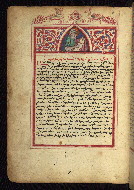
- Title: Decorated page with image of Eusebius
- Form: Full-page miniature
- Text: Letter of Eusebius to Carpianus
fol. 4r:
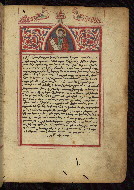
- Title: Decorated page with image of Carpianus
- Form: Full-page miniature
- Text: Letter of Eusebius to Carpianus
fol. 5v:
fol. 6r:
fol. 7v:
fol. 8r:
fol. 9v:
fol. 10r:
fol. 11v:
fol. 12r:
fol. 14v:
fol. 15r:
fol. 88v:
fol. 137v:
fol. 138r:
fol. 218v:
The binding is not original.
Brown goatskin over wooden boards, with a flap tooled in blind with small tools. The spine is decorated with a succession of vertical incisions and rises at the head and tail. The headbands are embroidered in red, black, and tan. The boards are lined with coarse blue linen. Each cover is overlaid with a plaque of silver worked in repoussé and finished by chiseling. The central panel of the upper cover depicts the Presentation in the Temple, and on the lower cover, the Ascension of Christ. Each scene is framed with a border of cherub heads. This silver binding, which is attributable to the seventeenth or early eighteenth century, was likely produced in Kayseri (Turkey).
Written by the priest Łazar, in 1488, at the monastery of Surb Awgsend (St. Auxentius) in the province of Ekełeac' (see colophons fols. 278r-279v)
Purchased by an individual named Ełiay before 1626
The book was rebound in 1626, and offered to the church of Surb Astuacacin (Holy Theotokos) in memory of Caruk, Kirakos, and Girigor (fol. 280r)
Owned by Xač'ik, who gave it to the church of Surf Parsam (St. Barsuma) (undated inscription fol. 280r)
Owned by a lady named Nonafar T'ṙkc'i before 1712 (undated inscription fols. 280r-280v)
Acquired by the priest Nersēs from an individual named Pahatur (fol. 281r)
Belonged to the church of Surb Lusaworič (St. Illuminator) (notation in modern hand on fol. 2r)
Henry Walters, Baltimore, acquired before 1931
Walters Art Museum, 1931, by Henry Walters' bequest
Mathews, Thomas F., and Roger S. Wieck, eds. Treasures in Heaven: Armenian Illuminated Manuscripts. New York: Pierpont Morgan Library, 1994, p.152, no. 11, figs. 83, 99.
Thanks are expressed to Professor Bernard Coulie (Université catholique de Louvain, Louvain-la-Neuve) for kindly making available his bibliography on the Armenian manuscripts kept in the Walters Art Museum.
Merian, Sylvie, L. “The Armenian Silversmiths Kesaria/Kayseri: Seventeenth and Eighteenth Centuries.” In Armenian Kesaria/Caesarea and Asia Minor. Ed. Richard G. Hovannisian, UCLA Armenian History and Culture Series, Historic Armenian Cities and Provinces, 12. Forthcoming 2013.
Der Nersessian, Sirarpie. Armenian Manuscripts in the Walters Art Gallery. Baltimore: The Trustees of the Walters Art Gallery, 1973, pp. 52-55, figs. 248-264.
Sanjian, Avedis K. A Catalogue of Medieval Armenian Manuscripts in the United States. Berkeley: University of California Press, 1976, pp. 305-309.
Merian, Sylvie, L.,“The Structure of Armenian Bookbinding and Its Relation to Near Eastern Bookmaking Traditions” (Ph.D. diss. Columbia University), 1993, pp. 81-82
Principal catalogers: Der Nersessian, Sirarpie; Landau, Amy; van Lint, Theo M
Catalogers: Herbert, Lynley; Noel, William
Editor: Herbert, Lynley
Copy editor: Dibble, Charles
Conservators: Owen, Linda; Quandt, Abigail
Contributors: Bockrath, Diane; Emery, Doug; Noel, William; Tabritha, Ariel; Toth, Michael B.
The Walters Art Museum
Licensed for use under Creative Commons Attribution-NonCommercial-ShareAlike 3.0 Unported Access Rights, http://creativecommons.org/licenses/by-nc-sa/3.0/legalcode. It is requested that copies of any published articles based on the information in this data set be sent to the curator of manuscripts, The Walters Art Museum, 600 North Charles Street, Baltimore MD 21201.
